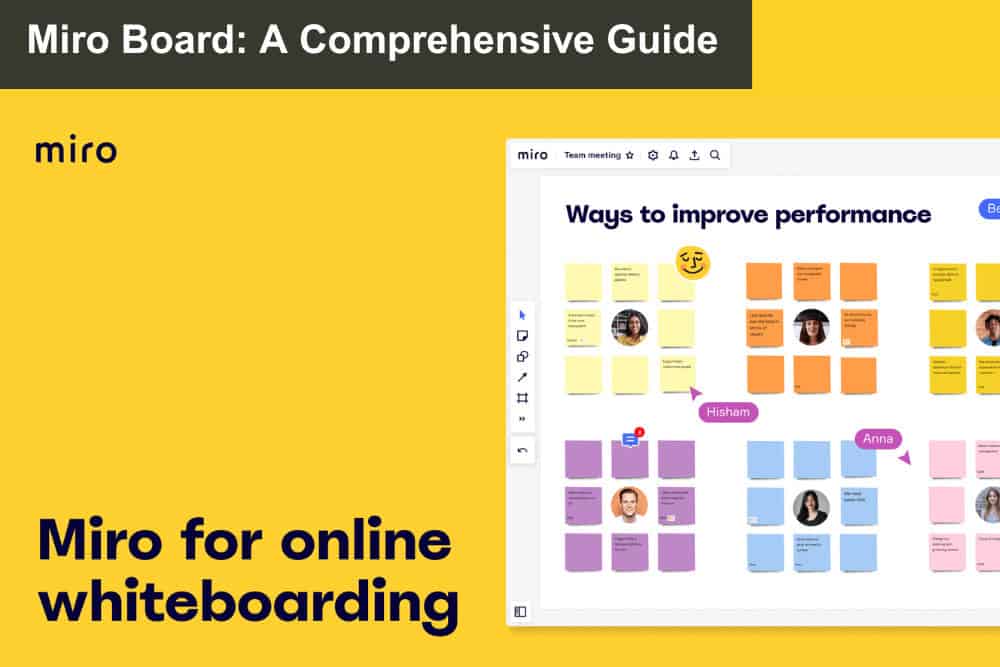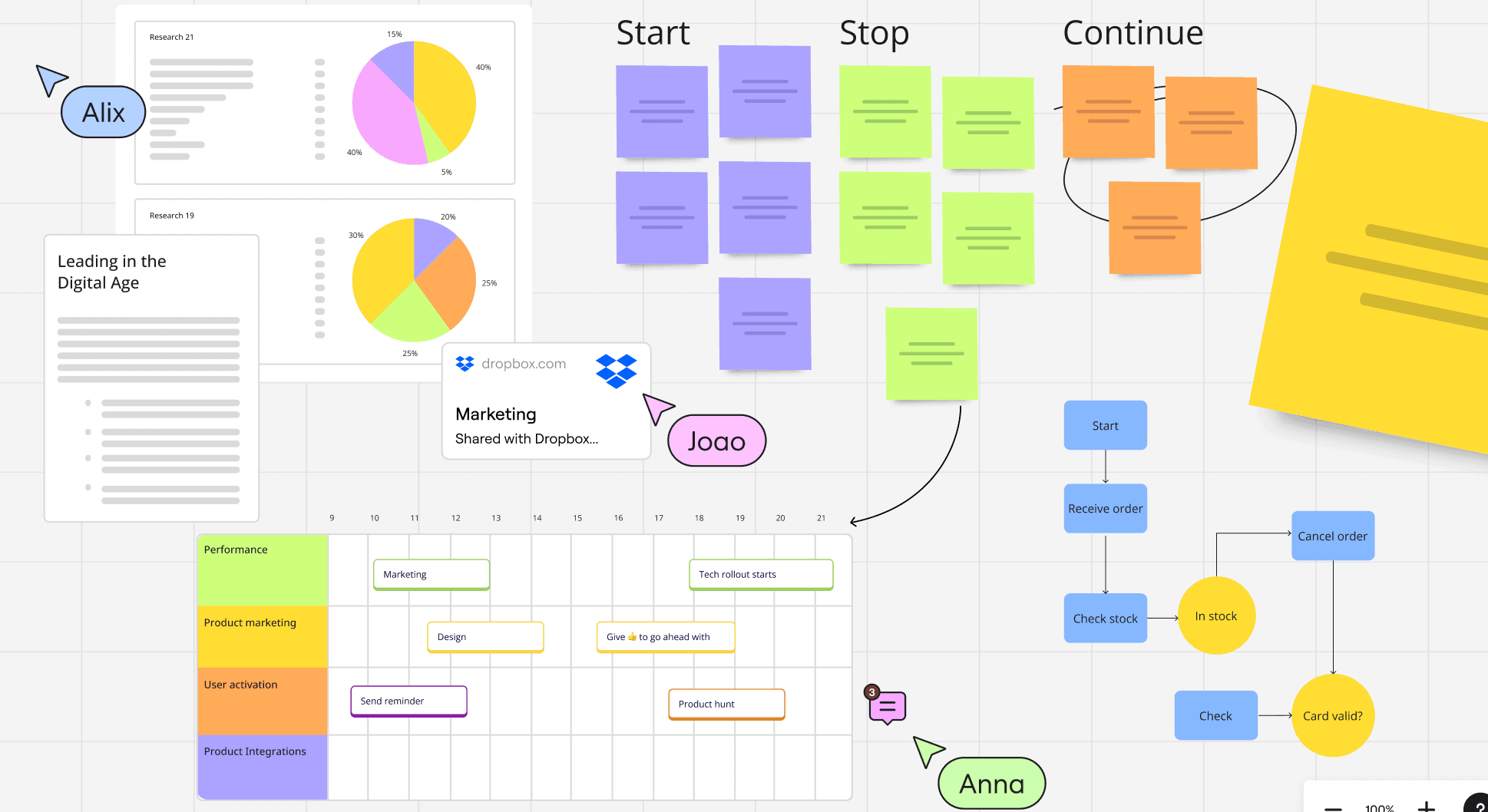
In today’s interconnected world, where ideas transcend borders and innovation is a collective endeavor, the ability to collaborate effectively has never been more crucial. Miro.com Board emerges as a shining beacon in this landscape, redefining how teams collaborate and bring ideas to life. It’s not just a tool; it’s a virtual workspace that bridges distances, synchronizes minds, and nurtures creativity.
If you find Miro pricing above your current budget, see if AceProject could serve you better. AceProject offers a powerful Board View.
Miro Board offers a unique platform that transforms traditional brainstorming and project planning into an engaging and dynamic experience. You can use it for everything from real-time collaboration to remote employee training. Whether you are part of a global corporation, a small startup, or an educational institution, the need for a cohesive and interactive collaborative environment is universal. Miro Board meets this need by providing a digital canvas that is both expansive and intuitive, allowing teams to visualize ideas, plan projects, and brainstorm solutions in real-time, no matter where they are located.

What is a Miro Board?
Miro.com Board is an advanced digital whiteboard that facilitates collaboration and idea visualization in real-time. It’s an online platform where teams can simultaneously create, discuss, and share ideas, regardless of physical location. The Board is a versatile canvas, suitable for various professional settings, from business meetings to creative brainstorming sessions.
How to Use Miro Board
- Getting Started: Sign up on Miro.com and create a new board.
- Navigating the Interface: Familiarize yourself with the toolbar, which offers options like sticky notes, shapes, and drawing tools.
- Adding Content: Click and drag items onto the canvas or use templates for structured activities.
- Collaboration: Invite team members to join and collaborate in real-time or asynchronously.
- Integration and Sharing: Integrate with other tools and share the board with external stakeholders.
Detailed Features of Miro Board
Miro Board stands out with its innovative features, each designed to enhance collaboration, creativity, and productivity in various real-life scenarios. Here’s a deeper look into some of these features and how they translate into practical applications:
- Infinite Canvas: Miro’s canvas’s limitless space is perfect for sprawling projects. Imagine a team of architects collaboratively designing a complex building layout or a marketing team plotting a year-long campaign strategy—the infinite canvas accommodates their expansive planning needs.
- Extensive Library of Templates: Miro’s templates serve diverse purposes, from business models to UX design. For instance, a startup might use the Lean Canvas template for business planning, while a software development team might choose a Sprint Retrospective template to review their progress.
- Interactive Tools:
- Voting: This tool democratizes decision-making. During a product development meeting, team members can vote on feature priorities, ensuring everyone’s voice is heard.
- Timers: Facilitators use timers in workshops or design sprints to keep activities on track and ensure efficient time use.
- Comment Sections: Ideal for asynchronous collaboration, comments allow team members in different time zones to leave feedback on a shared project plan or design mockup.
- Real-Time Collaboration: Changes made on the board are instantly visible to all participants, making it ideal for remote teams. For instance, a software team across continents can use this feature to conduct live debugging sessions or co-create software flowcharts.
- Integration with Other Tools: Miro’s compatibility with tools like Slack, Asana, and Zoom streamlines workflows. A project manager can integrate Miro with Asana to track project progress, while a team can use the Zoom integration during remote brainstorming sessions for enhanced interaction.
- Mind Mapping: This feature is invaluable for brainstorming sessions. Educational institutions use mind maps to teach complex subjects, helping students connect ideas and concepts visually.
- Wireframing and Prototyping: Design teams frequently use Miro to create wireframes and website or app prototypes. This visual approach helps align the team’s vision and get instant client feedback.
- Road mapping: Miro’s road mapping tools simplify strategic planning. Companies can plot long-term strategies, visually laying out milestones and objectives, making it easier for teams to understand and follow the roadmap.
- Document Embedding and Sharing: Teams can embed relevant documents directly onto the Miro board. For example, a legal team can share and collaboratively annotate contract drafts, or a research team can embed and discuss scientific papers.
- Sticky Notes and Drawing Tools: These are essential for ideation sessions. A creative agency might use sticky notes for a brainstorming session and then present finalized ideas more visually using a flipbook maker like Flipsnack, categorizing and rearranging concepts to develop innovative advertising campaigns.
Real-Life Use Cases of Miro Board
Miro Board’s versatility makes it a preferred choice for various industries and scenarios. Here are expanded real-life use cases illustrating its adaptability and effectiveness:
- Agile Project Management: Tech companies use Miro for Agile project management, creating scrum boards to track sprints, backlogs, and stand-ups, ensuring that the Agile process is visual, interactive, and efficient.
- Remote Education: With the rise of remote learning, educators employ Miro to create engaging, interactive lessons. For instance, a history teacher might use Miro to build a collaborative timeline of historical events with students.
- Brainstorming Sessions in Advertising: Advertising agencies leverage Miro to brainstorm campaign ideas. Teams collaboratively sketch out ad concepts, tag-team on creative strategies, and visualize consumer journeys.
- UX/UI Design Collaboration: UX/UI designers use Miro to collaborate on wireframes, user flow diagrams, and prototype designs, enabling real-time feedback and iteration from team members and clients. It can also work as a flowchart tool when mapping user navigation paths.
- Strategic Business Workshops: Companies use Miro to conduct SWOT analysis, stakeholder mapping, and goal-setting sessions. This visual approach helps in aligning team members on business strategies and objectives.
- Product Roadmapping: Product teams in various industries use Miro to plot product development roadmaps visually, aligning cross-functional teams on timelines, deliverables, and milestones.
- Event Planning: Event planners utilize Miro to lay out event plans, track vendor responsibilities, and coordinate team tasks, ensuring every detail is accounted for in complex event orchestration.
- Cross-Functional Team Alignment: Large organizations use Miro to facilitate cross-departmental collaboration, ensuring that teams like marketing, sales, and product development are aligned on company-wide initiatives.
- Customer Journey Mapping: Marketing teams map out customer journeys to visualize the customer experience, identify pain points, and strategize improvements, resulting in more effective marketing plans.
- Research and Development: R&D teams in sectors like pharmaceuticals and technology use Miro to document research findings, develop hypotheses, and collaboratively explore innovative solutions.
- Non-Profit Strategy Planning: Non-profit organizations use Miro to plan outreach campaigns, organize fundraising strategies, and brainstorm ways to engage with their communities.
- Creative Writing Workshops: Writers and educators use Miro to host collaborative writing workshops, where participants can collectively draft stories, share feedback, and develop narratives.
- Consulting and Client Work: Consultants use Miro to facilitate workshops and strategy sessions with clients, providing a shared space for problem-solving, creativity, and planning.
- Workshop Facilitation: Facilitators use Miro in workshops for real-time collaboration, allowing participants to contribute ideas, vote on concepts, and visualize group thinking.
Conclusion
Miro.com Board is more than just a digital whiteboard; it’s a powerful catalyst for collaboration, innovation, and productivity. Its diverse features and real-life applications make it an indispensable tool for modern professionals seeking to enhance their collaborative efforts. Whether for project planning, creative brainstorming, or educational purposes, Miro Board offers a flexible and interactive platform to bring your ideas and teamwork to life.
Suggested articles:
- The Pros and Cons of Using Miro Software
- Miro Pricing Plans & Costs Guide
- 12 Tools for Effective Remote Team Management
Daniel Raymond, a project manager with over 20 years of experience, is the former CEO of a successful software company called Websystems. With a strong background in managing complex projects, he applied his expertise to develop AceProject.com and Bridge24.com, innovative project management tools designed to streamline processes and improve productivity. Throughout his career, Daniel has consistently demonstrated a commitment to excellence and a passion for empowering teams to achieve their goals.